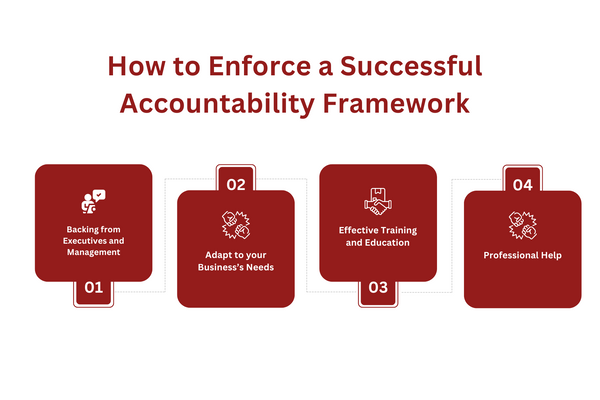A Numbered List to follow for Accountability Framework Implementation

An Accountability Framework is a structured approach that organizations use to ensure they are meeting their responsibilities and obligations, particularly in the context of compliance, governance, and ethical behavior. Here’s a complete guide to understanding and implementing an Accountability Framework:
What is an Accountability Framework?
An Accountability Framework is a system of policies, processes, and tools designed to hold an organization and its employees accountable for their actions and decisions. It encompasses a set of principles and practices that ensure transparency, responsibility, and ethical behavior across all levels of the organization.
Key Components of an Accountability Framework
- Governance Structure:
- Leadership and Oversight: Clearly defined roles and responsibilities for leaders and managers to oversee compliance and accountability.
- Committees and Boards: Establishment of committees or boards to monitor and review accountability measures.
- Policies and Procedures:
- Code of Conduct: A comprehensive code of conduct outlining expected behaviors and ethical standards.
- Compliance Policies: Detailed policies on compliance with laws, regulations, and internal standards.
- Risk Management:
- Risk Assessment: Regular assessment of risks related to non-compliance and unethical behavior.
- Mitigation Strategies: Implementation of strategies to mitigate identified risks.
- Performance Measurement and Monitoring:
- Key Performance Indicators (KPIs): Metrics to measure compliance and ethical performance.
- Regular Audits: Internal and external audits to ensure adherence to policies and procedures.
- Reporting and Transparency:
- Whistleblower Mechanisms: Safe and confidential channels for reporting unethical behavior or non-compliance.
- Transparency Reports: Regular reporting on accountability measures and outcomes to stakeholders.
- Training and Awareness:
- Employee Training: Ongoing training programs to educate employees about their responsibilities and the importance of compliance.
- Awareness Campaigns: Initiatives to raise awareness about the organization’s accountability framework.
- Continuous Improvement:
- Feedback Mechanisms: Systems for receiving and incorporating feedback from employees and stakeholders.
- Regular Reviews: Continuous review and improvement of the accountability framework to address new challenges and regulatory changes.
Implementing an Accountability Framework
- Establish Leadership Commitment:
- Secure commitment from top management to drive the importance of accountability and allocate necessary resources.
- Define Clear Objectives:
- Set clear objectives for what the accountability framework aims to achieve in terms of compliance and ethical behavior.
- Develop and Communicate Policies:
- Develop comprehensive policies and ensure they are effectively communicated to all employees.
- Implement Risk Management Processes:
- Conduct regular risk assessments and implement strategies to mitigate identified risks.
- Train Employees:
- Provide ongoing training to ensure employees understand their roles and responsibilities within the framework.
- Monitor and Measure Performance:
- Use KPIs and regular audits to monitor compliance and performance against the framework.
- Foster a Culture of Accountability:
- Encourage a culture where accountability is valued and integrated into daily operations.
- Ensure Transparency and Reporting:
- Maintain transparency through regular reporting and provide mechanisms for confidential reporting of issues.
- Review and Improve:
- Continuously review the framework and make necessary improvements to address emerging challenges.
Benefits of an Accountability Framework
- Enhanced Compliance: Ensures adherence to laws, regulations, and internal policies.
- Improved Risk Management: Identifies and mitigates risks associated with non-compliance and unethical behavior.
- Increased Transparency: Builds trust with stakeholders through transparent practices and reporting.
- Better Decision-Making: Facilitates informed decision-making based on ethical standards and compliance requirements.
- Stronger Organizational Culture: Promotes a culture of accountability and ethical behavior within the organization.
By implementing a comprehensive Accountability Framework, organizations can ensure they meet their obligations, manage risks effectively, and foster a culture of transparency and responsibility. This not only helps in complying with legal and regulatory requirements but also enhances the overall integrity and reputation of the organization.
With the guide above you should have a guide that you can now follow. Please contact a Captain Compliance representative with any questions.